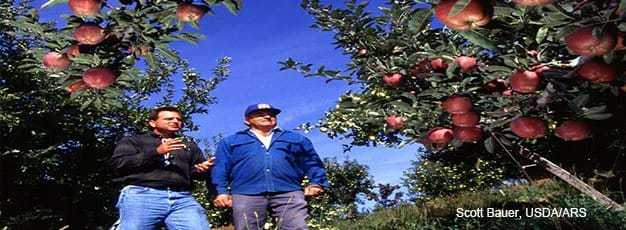Meeting Fruit and Vegetable Dietary Recommendations

The average American diet falls short of the daily recommendations for fruit and vegetables in the 2005 Dietary Guidelines for Americans and in the supporting MyPyramid Food Guidance System. If Americans adopt diets that more closely follow the new guidelines, changes in the mix and quantity of foods produced in the U.S. would be substantial.
A recent ERS report provides estimates of the potential implications for U.S. agriculture if Americans change their consumption patterns to meet the 2005 recommendations. This straightforward extrapolation using ERS Food Guide Pyramid Servings data holds U.S. exports constant and holds the relative shares of production and imports constant at the average of 1999-2003 levels. U.S. farmers would grow more of the produce they grow now, and fruit and vegetable imports would increase.
If Americans were to fully meet the recommendations for fruit, they would need to increase daily fruit consumption by 132 percent. The additional demand would require U.S. producers to more than double annual harvested fruit acreage from 3.5 million to 7.6 million. As part of the dietary change, daily vegetable consumption would need to rise by about 31 percent, and the mix of vegetables consumed would need to change. For example, consumption of legumes, like kidney beans and lentils, would have to increase fourfold, and consumption of starchy vegetables would have to decline by a third. Accordingly, annual harvested acres of vegetables in the U.S. would need to increase by about 137 percent, from 6.5 million to 15.3 million, to meet this new demand. Most of this increase is due to higher acreage for legumes. Meanwhile, acreage for starchy vegetables would need to decrease.
These estimated acreage increases for both fruit and vegetables amount to almost 3 percent of total U.S. cropland in 2002. The additional acreage would likely come from current high-production areas or contiguous areas that have similar production characteristics, such as favorable climate and arable land.
Eating patterns change slowly in response to new dietary or medical information, changing tastes and preferences, and availability of new food products. Over time, Americans may make dietary changes that move them closer to the recommended intakes of fruit and vegetables, moving U.S. agriculture toward the production levels discussed here.
| Food group | Dietary Guidelines recommendations for a 2,000-calorie diet (cups per day) |
Servings available in 20031 (percent) |
Change needed to meet recommendations2 (percent) |
|---|---|---|---|
| Fruit | 2.0 | 0.9 | 132 |
| Vegetables | 2.5 | 1.9 | 31 |
|
Dark green
|
0.4 | 0.2 | 175 |
|
Orange
|
0.3 | 0.1 | 183 |
|
Legumes
|
0.4 | 0.1 | 431 |
|
Starchy
|
0.4 | 0.7 | -35 |
|
Other
|
0.9 | 0.9 | 2 |
| 1Adjusted for losses from marketing and spoilage. 2Computed from unrounded numbers. Source: Prepared by USDA, Economic Research Service. |
|||
Possible Implications for U.S. Agriculture From Adoption of Select Dietary Guidelines, by Jean C. Buzby, Hodan Farah Wells, and Gary Vocke, USDA, Economic Research Service, November 2006
Food Availability (Per Capita) Data System, by Linda Kantor and Andrzej Blazejczyk , USDA, Economic Research Service, September 2024

